

Roman Roads
The Romans were famous for their roads, and this page describes how Roman roads were built and how you could use the topic in the classroom.
The Romans built roads so that the army could march from one place to another. They tried to build the roads as straight as possible so that the army could take the shortest route.
How the Road was Built…
1) First, the army builders would clear the ground of rocks and trees. They then dug a trench where the road was to go and filled it with big stones.
2) Next, they put in big stones, pebbles, cement and sand, which they packed down to make a firm base.,
3) Then, they added another layer of cement mixed with broken tiles.
4) On top of that, they then put paving stones to make the surface of the road. These stones were cut so that they fit together tightly.
5) Kerb stones were put at the sides of the road to hold in the paving stones and to make a channel for the water to run away.
1) Print the diagram below and photocopy it. Then ask the children to draw the diagram into their books and put the following sentences into the correct place on their diagrams.
| 1) At the bottom of the trench, the Romans put a layer of big stones. |
| 2) Broken stones, pebbles, cement and sand to make a firm base. |
| 3) Cement mixed with broken tiles. |
| 4) Paving stones formed the surface of the road. These were cut so they fit together tightly. |
| 5) Kerb stones at the sides held in the paving stones and made a channel for the water to run away. |
The above activity can also be found on the worksheet below.
2) If you have suitable materials (i.e. different sized rocks and pebbles, sand etc.), you could ask your children to make a model of the road, using the instructions above.
3) Give the children a copy of a map of Britain. Ask them to draw on the location of some Roman roads using the information below:
| This table shows where some Roman roads started and ended. Draw the roads on your map by joining the towns with a line. |
| London to Dover |
| Chester to York |
| London to Lincoln to York (this road was called ERMINE STREET) |
| Chester to Carlisle |
| Exeter to Dorchester to Silchester |
You could ask the children to find the location of more Roman roads using different reference sources, and they could also find out the Roman names for the towns and cities which are joined by the roads.
Download File
The Maths Games Pack
Design technology tools, you may also like, latin words and their meanings, world war 2 day ideas, stone age day ideas, ways to use lego in the classroom, teaching ideas for a tudor day, teaching ideas for a greek themed day, leave a comment cancel reply.
Save my name, email, and website in this browser for the next time I comment.
Join our Newsletter
Get new teaching ideas and resources in your inbox every week!
FREE EMAIL UPDATES!
- International
- Education Jobs
- Schools directory
- Resources Education Jobs Schools directory News Search

Romans - Roman Roads 3/8
Subject: History
Age range: 11-14
Resource type: Lesson (complete)
Last updated
18 February 2024
- Share through email
- Share through twitter
- Share through linkedin
- Share through facebook
- Share through pinterest

Lesson 3: Roman Roads
THIS RESOURCE INCLUDES:
• Lesson teacher tutorial video for this lesson (for homework/home school learning) • Literacy & Numeracy settler • Contextual information and maps (to assist teacher talk) • Documentary clips activity with extension task • Guided reading task • Roman road diagram and labelling activity • Paragraph writing skills activity. • Knowledge check plenary • All resources required included at the end of the PowerPoint file. • Online self marking quiz to assess understanding
OTHER LESSONS IN THE SERIES:
Lesson 1: Roman Intro Lesson 2: The Founding of Rome, Romulus and Remus Lesson 4: The Roman Army Lesson 5: Punic Wars Lesson 6: Pompeii & Roman Life Lesson 7: Roman Government (The Republic) Lesson 8: Medicine and Public Health
An 8 lesson series guiding Key Stage 3 through some of the fundamentals of the Roman Empire. Tried and tested over a number of years. See details of each lesson below the initial list.
Each lesson focusses on the Video – Resource – Quiz structure to allow for maximum support for teachers and parents – and maximum independence for students.
WolseyAcademy.com , a non-profit resource provider, directs all profits to various charities, including refugee support, youth sports, educational programs, and carbon capture, achieving a carbon-negative status. Explore our site for resources and free history role-playing games loved by students. Thank you for your dedication to teaching and for supporting our mission.
Creative Commons "Sharealike"
Your rating is required to reflect your happiness.
It's good to leave some feedback.
Something went wrong, please try again later.
This resource hasn't been reviewed yet
To ensure quality for our reviews, only customers who have downloaded this resource can review it
Report this resource to let us know if it violates our terms and conditions. Our customer service team will review your report and will be in touch.
Not quite what you were looking for? Search by keyword to find the right resource:
The Beautiful Network of Ancient Roman Roads

In today’s terms, it’s hard to fathom how much of the world the Romans once controlled. At its peak, the Roman Empire spanned from Hadrian’s Wall in Scotland to Morocco, from the banks of the Rhine River bordering Germania, to Egypt, and east to the Euphrates River in Mesopotamia—a huge swath of conquered peoples and occupied lands, with barbarians on the borders.
Thousands of years later, monuments of Roman glory and imperialism still stand throughout Europe. Huge concrete buildings like the Colosseum remain, as do stone plinths and obelisks.
But the Romans’ most impressive achievement, and most important contribution to modern Europe, lies underfoot.
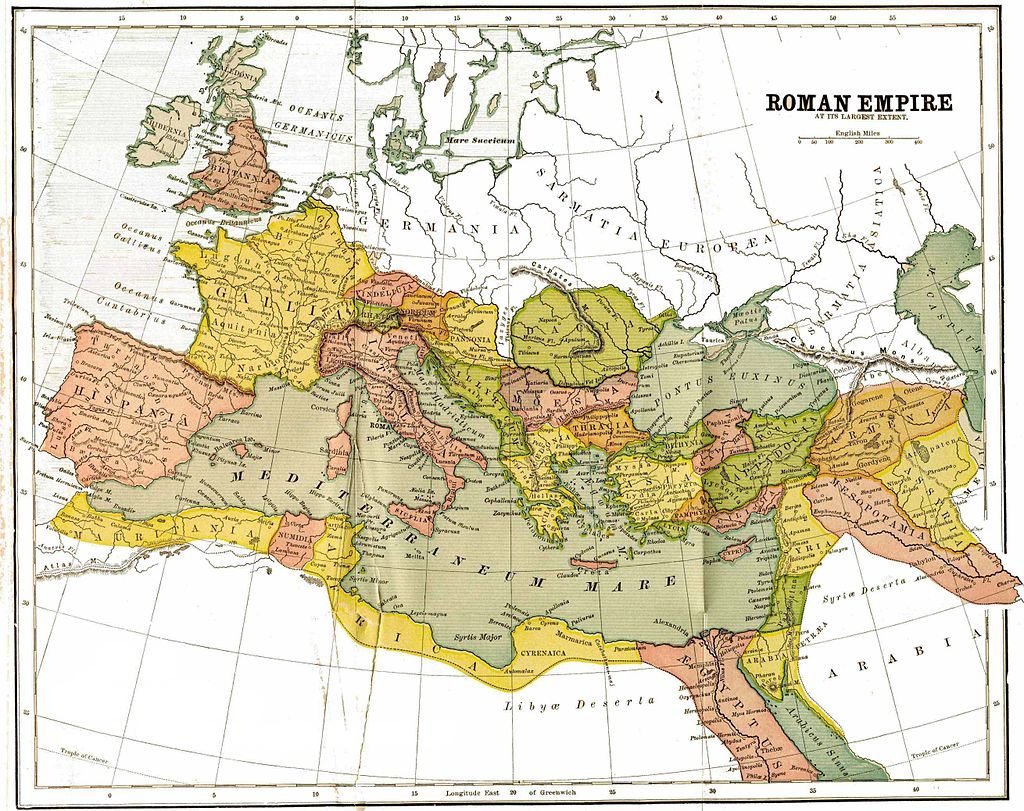
Roads, built to allow the empire to flow outward, and for the rewards of empire to come flooding back to the capital, were the key to the Romans’ governance of Europe. Along these roads ran messengers, as a type of precursor to the American Pony Express —a relay of horsemen could carry a message 50 miles a day. Governors, emperors, legions, and, most importantly, trade flowed along these ribbons of stone that cut through hills and across gorges. In 9 BCE, the Emperor Tiberius rode almost 215 miles along the roads in 24 hours to get to his dying brother’s side. For a small toll, other, non-official travelers could travel the roads as well.

Roman roads are still visible across Europe. Some are built over by national highway systems, while others still have their original cobbles—including some of the roads considered by the Romans themselves to be the most important of their system.
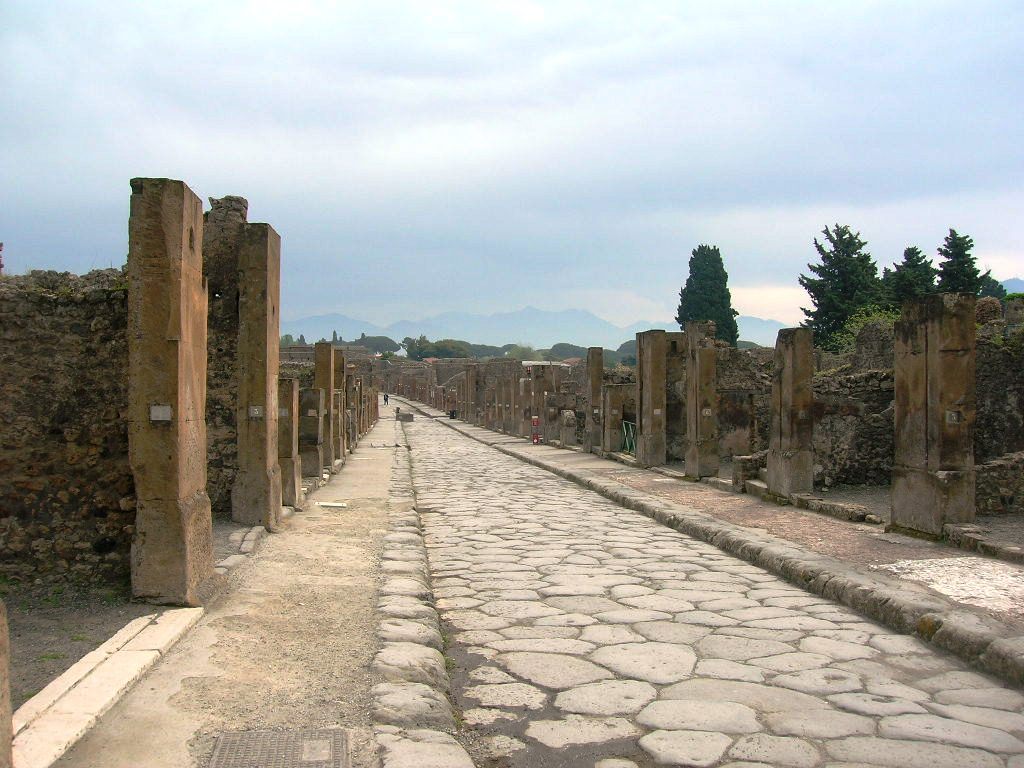
One major road you can still visit is via Appia , or Appian Way, the most strategically important of the Roman roads. Begun in 312 BCE, the road runs from Rome southeast to the coastal city of Brindisi, a distance of 350 miles. It was via Appia that allowed for the Roman conquest of southern Italy, and the defeat of the Greek city-states and colonies embedded there.
The Appian Way was host to battles between the Romans and the Greek general Pyrrhus from 280 to 275 BCE, which is where we get the term “Pyrrhic victory:” a victory that comes at too high a cost. Via Appia was also the site where, in 71 BCE, around 6000 members of Spartacus’s slave army were crucified on the hillsides.
The road also has more recent military history—it was the site of the 1944 Battle of Anzio during the Second World War, in which the Allies became mired in the same swamp that threatened to fell Pyrrhus two millennia earlier.

In France (Gaul) and Spain (Hispania), the road systems were no less impressive than in Italy—the Alcantara Bridge, over the Tagus River, was built in 106 AD, and carries the inscription “Pontem perpetui mansurum in saecula,” or “I have built a bridge which will last forever.” This is not strictly true. While the bridge still stands, it was damaged, first by Moors in 1214, then by the Spanish in 1762, and again in 1809. There are, in fact, two bridges in Spain named Alcantara, built by the Romans, and a third, similarly named bridge, the Alconetar Bridge—all of which span the Tagus, in Western Spain. The word “Alcantara” comes from the Arabic word “al-qantarah”, which means “bridge”.
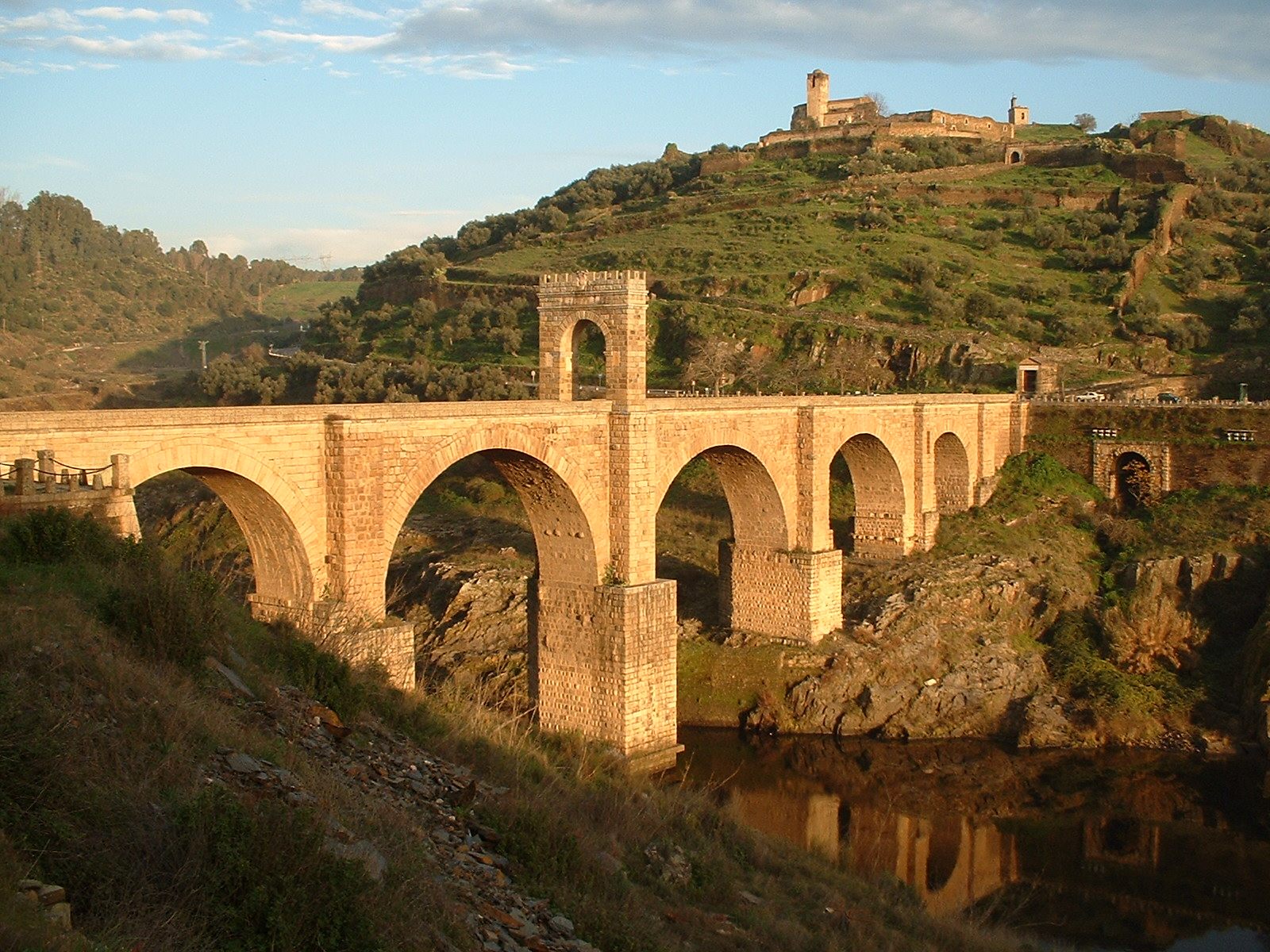
The Romans also acquired roadways and Latinized them—the via Domitia, which ran between Italy and Hispania through southern France, was an ancient path that the Romans paved in 118 BCE. Prior to the Roman upgrade, the path featured in Greek mythology as the legendary route of Heracles when he drove the cattle he stole from Geryon along it. This road was also the one travelled by the Carthaginian general Hannibal when he invaded Italy in 218 BCE. Along the via Domitia lie the remains of two bridges, one of which, the Pont Julien, is passable to foot traffic. The other, the Pont Ambroix, is ruined but beautiful.
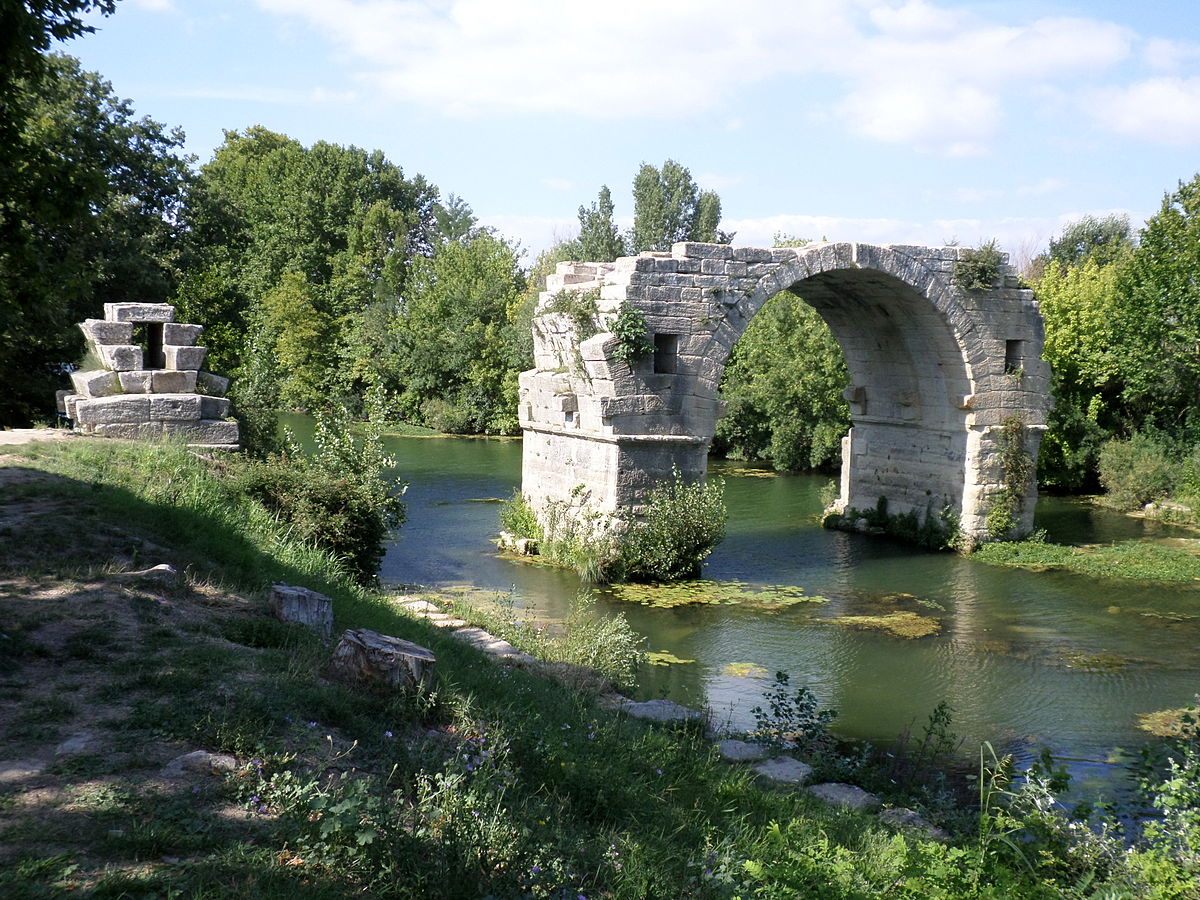
Along the Roman road via Julia Augusta, which also runs through the south of France, there are the remains of a number of bridges. The Pont Flavien is in the best condition, and is perhaps the most archaeologically important: it is the only surviving example of its kind of bridge, and was constructed as a funerary monument. It was heavily used until the end of the 20th century, and has been extensively repaired. Pont Flavien has sustained a lot of damage in the last few hundred years—part of it collapsed in the 18th century, and, during the Second World War, both a German tank and an Allied truck crashed into one of the archways. The bridge is now reserved for foot traffic.

Then there are the world famous archways of the aqueduct that crosses the Gardon River, the Pont du Gard. Built in the first century, the aqueduct and bridge stand in such good condition due to their being used as toll roads during the Middle Ages. Originally the bridge was used for vehicular and pedestrian traffic, but access is now restricted to pedestrians.
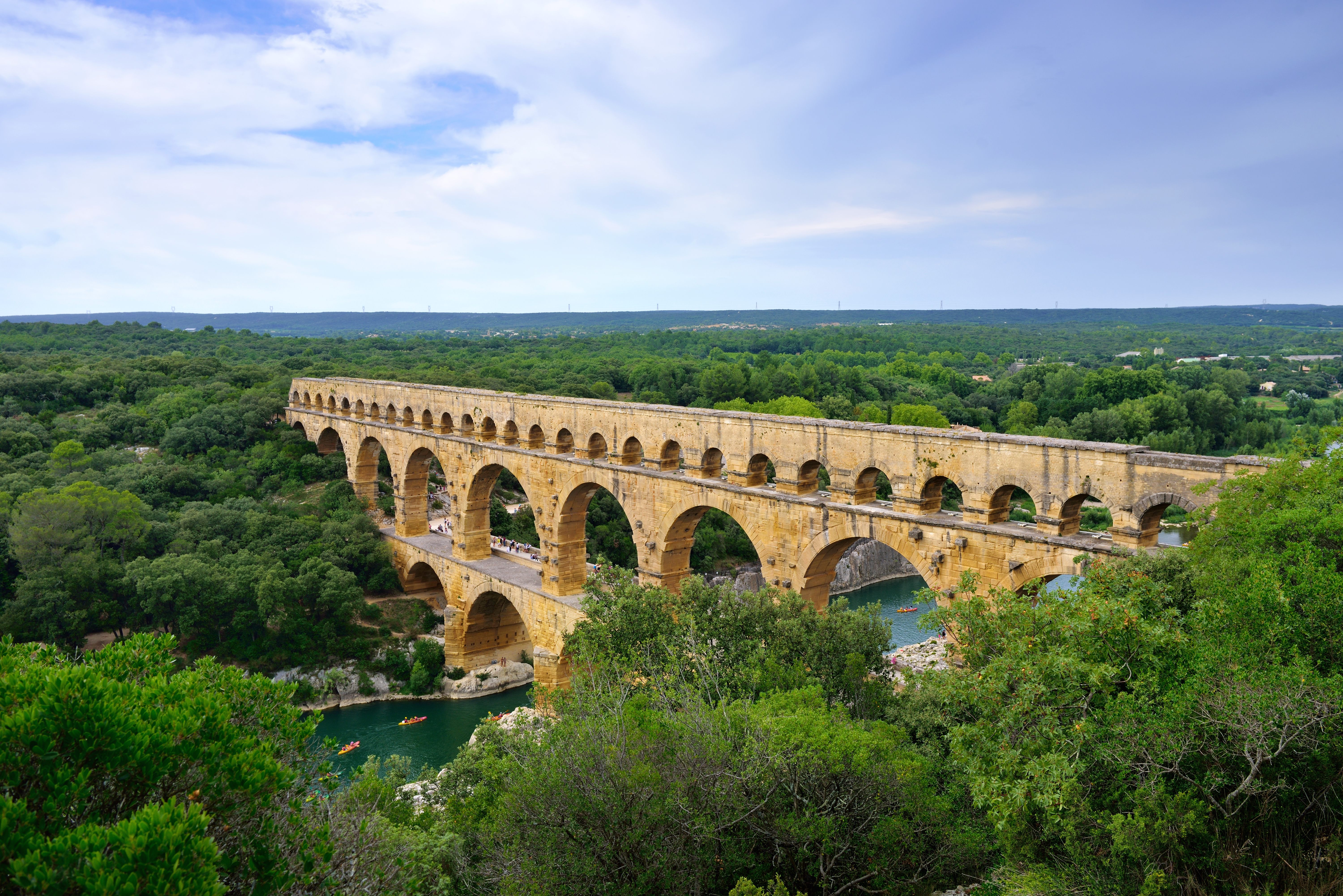
In contrast to Hispania and Gaul, the Roman Empire never made much headway into Germania. Much of the Roman road network in the former Britannia has been built over or has decayed. Beginning their work in 43 CE, alongside the invasion organized by the Emperor Claudius, the Romans quickly built a road network through the lands they controlled in Britain. Although parts of this network remained in place, most roads quickly decayed after the Roman withdrawal. Modern roads cover much of the network—an example is the M20 motorway in Canterbury, beneath which lies a road known as Stone Street. There are ruins of bridges still visible, such as in Northumberland, where parts of Hadrian’s Wall and Chesters Bridge can be seen, as well as in Durham, at Piercebridge.
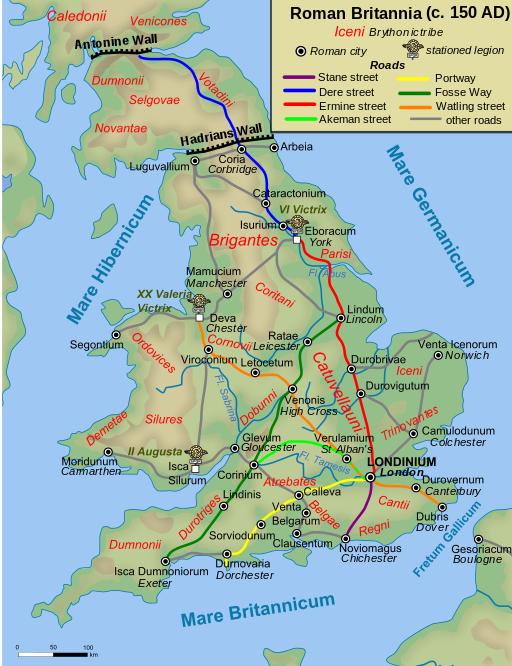
Few roads remain in Germany, but the oldest still-standing bridge in the country is of Roman origin: the Manfred Bridge, in Trier. A UNESCO World Heritage site , the bridge spans the river Moselle, near the German border with Luxemburg. It is believed to date from the second century CE.
If we head east, through Dalmatia (modern Croatia) and Thracia (parts of modern day Greece, Bulgaria, and Turkey), we can travel Roman roads like the via Militaris, which ran from what is now Belgrade to what is now Istanbul. A section of the road is today visible in Dimitrovgrad, Serbia.
By taking the via Pontica you can see the craggy, ruined remains of Trajan’s bridge, which was built in 103 CE to cross the Danube in Romania. Much of it was destroyed by Trajan’s successor, Hadrian, as a precaution against invading hordes.
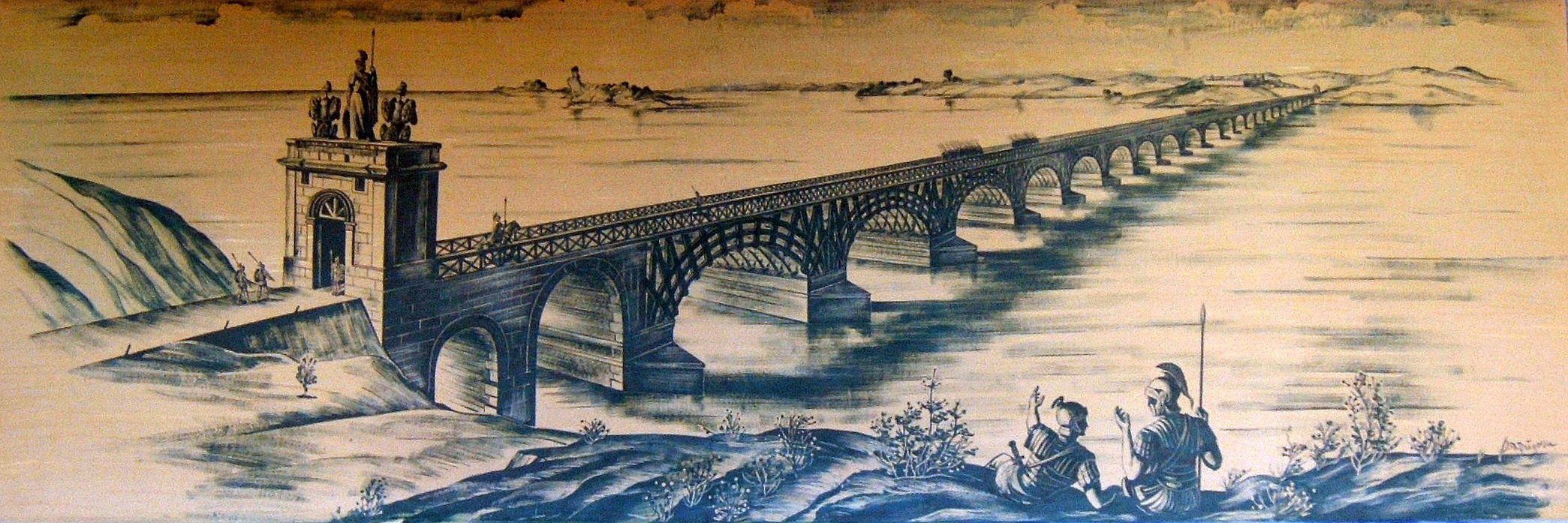
In Turkey there are still some Roman roads and bridges, like in Cilicia, or at Cendere Cayi, where the Severan Bridge steps 112 feet across the creek. Throughout Asia Minor and the Middle East ran a number of Roman roads, sometimes their own creations, other times imposed on top of existing roads. The via Maris (which translates to the “way of the sea”) connected Aegyptus (Egypt) with Syria, Palaestina Judae, Cappadocia and onto the rest of the Empire. It traces an ancient trade route that was in existence from the early Bronze Age, and was originally called the Way of the Philistines. The via Regia (later the via Traiana Nova) was also built on an ancient trade route—the King’s Highway, which stretched between Egypt and Damascus. The most well-known Roman road in the Middle East, however, was built in the first century, and leads to Petra , through the gates of the city.
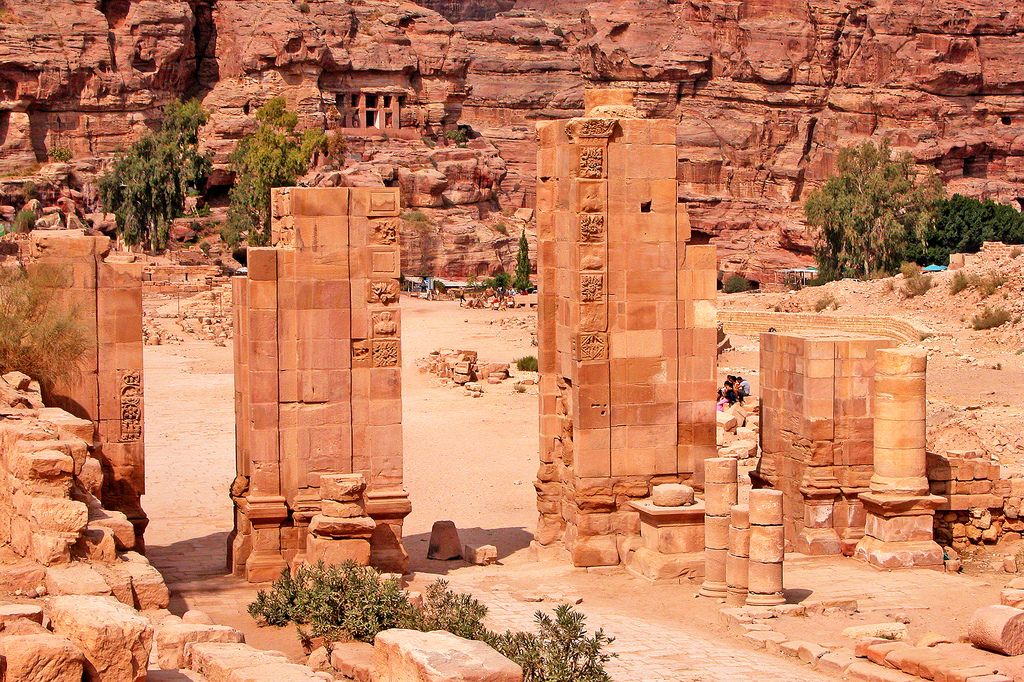
There are also a number of Roman bridges in the Middle East. Band-e Kaiser (Caesar’s Dam) was a Roman bridge and dam built by contracted Roman workers in the third century CE. It is the easternmost Roman bridge and dam, as Iran was, at that time, part of the Persian Empire, not the Roman one. According to legend, Shapur I captured the Roman Emperor Valerian circa 257 CE, and forced him and his army to build the dam and bridge. This is what remains of it now:

This Mystery Photo Haunting Reddit Appears to Be Image Recognition Gone Very Weird

Using an ad blocker?
We depend on ad revenue to craft and curate stories about the world’s hidden wonders. Consider supporting our work by becoming a member for as little as $5 a month.

A Very Modern Map of Britain's Ancient Roman Roads

Found: A Silver Snake Ring Dating Back to Roman Britain

The Perfect 22-Foot Map for Your Ancient Roman Road Trip

How Women Used Cars To Fuel Female Empowerment

Follow us on Twitter to get the latest on the world's hidden wonders.
Like us on Facebook to get the latest on the world's hidden wonders.

Pre-Order Atlas Obscura: Wild Life Today!
Add some wonder to your inbox, we'd like you to like us.

Home » Romans
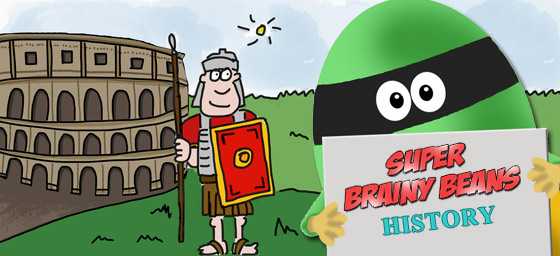
The Romans facts
The Romans facts for kids KS2 learning at Primary School. Homework help with the history of Romans, the Roman Empire and places to visit in the UK where you can learn more about the Romans.
Time: 750BC - 500AD
How did the Romans begin?
The legend says there were two twins called Romulus and Remus. When their uncle decided to have them killed they were put in a trough and into the River Tiber. They were found by a wolf and a woodpecker, and then raised by a shepherd. The twins eventually went back to the River Tiber where they were found, and created A city. Romulus set a boundary around the city to keep his brother out. but his brother Remus crossed the boundary and Romulus killed him and named the city after himself. The city of Rome.
It was nearly 3,000 years ago when the population of Rome started to grow into the most powerful city in Italy. It was ruled by Kings until the last king was driven out. The city then choose their own leaders, a group of men who came from the most important families. This was the beginning of the Roman Empire as the Romans (the people of Rome) controlled the whole of Italy.
The Roman Empire
The Roman Empire grew even more and took control of many counties in Europe, the Middle East and North Africa over the next 500 years. The Romans were ruthless and bloodthirsty and had a strong army so they won battles and took over the land. But the Romans didn't stop there, they wanted to control even more land.
A gladiator slave called Spartacus gathered a group of Gladiators together to revolt (do battle) against the Roman army. After a year of travelling through the Roman Empire doing battles, they still haven't managed to take control of Rome. Eventually, Spartacus died in battle and the other gladiators were crucified by the Roman army.

Who was Julius Caesar?
As the Romans became more powerful and took more land, the Senators started to argue how they should run the land. In 49BC a man called Julius Caesar came to Rome with his army and took power. Although he tried to make peace, the Senators thought he might become another king and not wanting that again, they killed him.
Who was the first emperor of Rome?
While the Senators still argued, Julius Caesar's great-nephew, Augustus, fought and won control of Rome. He became Rome's first emperor. Altogether, there were 147 Roman Emperors over the whole time the Roman Empire ruled.
Horrible Histories - Rotten Romans
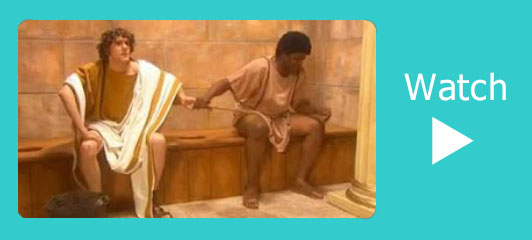
The Roman Army
Over the next 150 years, the Romans took control of even more land. They had a strong, well-organised army that could surround a whole city so no one could get out and then eventually, force their way in. Soldiers were very well trained and could march over 50km (30 miles) a day. Any healthy man who was aged between 17 and 46 had to join the army. They would then remain in the army for 25 years.
Places to see Romans
Roman britain.
By 55 BC The Roman Empire had reached Britain where the Celts controlled the land. In their first invasion, under Julius Caesar's rule, the Celts won and the Romans didn't get what they wanted. So they tried again 100 years later when Emperor Claudius was ruling. This time they won and took control of southern Britain.
The Celts, not happy with the invasion tried to fight back, but the Roman army was too powerful and each time the Romans defeated them.
The Romans never managed to control Scotland as it was ruled by fierce warrior tribes. In the end, the Romans built a wall called Hadrian's wall in the north of England to keep those fierce warriors out.
Roman facts
- Romans were great engineers. They built everything from road, bridge and aqueducts (raised channels to carry water), to drains, sewers and the first-ever block of flats.
- Public bath-houses were a great way for Romans to relax and meet friends. They had hot and cold swimming pools, sports facilities and offered massages and beauty treatment.
- Before having a bath Romans would rub olive oil over there bodies and scrape it off with metal scrappers called strigils.
- The Romans were the first to have underfloor heating. Hot air, heated by a furnace and circulated through brick-lined pipes underneath the floor.
- Romans spent their time by eating, drinking, gambling, going to the theatre, chariot races or gladiator fights.
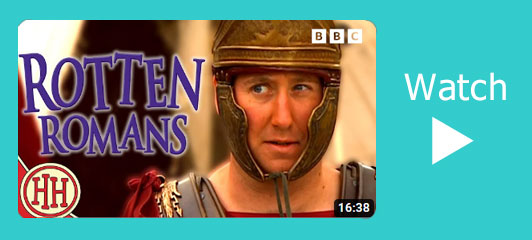
Follow Super Brainy Beans's board Romans on Pinterest.
What is Hadrian's wall?
Hadrian's wall was ordered to be made by the Roman emperor Hadrian. It is 117 kilometres long and 4.5 metres high in places. Built-in the north of England, its main purpose was to keep out Celtic raiders.
How did the Roman Empire end?
Around 200AD, the Roman Empire started to fall apart with soldiers were choosing their own emperors and fighting among themselves. In 395AD, the Roman Empire became split permanently into two, East and West.
Then the city of Rome was attacked twice. A Visigoth chief called Odoacer made himself King of Italy and ended the Western Empire. The Eastern Empire continued for another thousand years.
Also on Super Brainy Beans
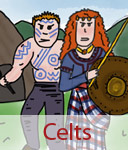

Lessons and resources for primary history
Home > Romans > Romans Curriculum Ideas
Curriculum Ideas

Make Roman tile mosaics
Create a clay sculpture of a Roman emperor or a statue of a Roman god
Design a pop up Roman landmark (we like these pop-up Colosseums )
Make your own Roman coins
Explore ways of representing exploded volcanoes using paint techniques ( check out these for inspiration)

Use programming software to design an obstacle course for a Roman gladiator character
Make a stop-motion animation of the story of Boudica or Romulus & Remus
Create and edit a video of your own version of one of the many Roman story books available

Design & build a Roman aqueduct model that really carries water
Make a pair of Roman sandals that fit your feet
Make and evaluate a Roman catapult (you can find instructions here )
Make your own chocolate Roman road (check out our instructions pack )

Make maps to show the expansion of the Roman empire
Find out about how volcanoes are formed and where they are found
Compare the capital cities of Italy and the UK
Map out where Romans built roads in the UK
Make a tourist guide to Hadrian's Wall or another Roman site

Find out about how the Roman Empire expanded and how the Romans invaded Britain
Follow the KS2History scheme of work for Roman Britain

Create your own narrative based on Escape from Pompeii (see the KS2History Escape from Pompeii planning unit )
Write newspaper reports about an aspect of Roman life (check out The Roman Record for inspiration)
Write instructions for becoming a gladiator and making chocolate Roman roads (see the KS2History Romans Instructions Unit )
Create a diary from the point of view of a Celt during the time of the invasion.
Write book reviews for a book about the Romans (check out our book reviews to get you started).

Figure out Roman road routes around your school using only straight lines and right angles
Learn to count using Roman numerals
Try this BBC Romans shopping challenge and extend it with your own numbers
Investigate the areas of different Roman villas
Weigh out ingredients to make Roman bread. Work out how you would need to scale up the ingredients for a class feast

Explore beats and rhythms for the Roman army to march to
Research Roman musical instruments
Learn a song about the Romans ( like this one ) and perform it to an audience

Investigate the best materials for Roman helmets or shields
Make your own exploding volcanoes ( instructions can be found here ) and find out about the chemical reactions involved
Investigate different ways of cleaning old Roman coins. Try cola, vinegar, lemon juice or baking soda
Find out what kind of armour Roman soldiers wore to protect their bodies
Learn about our skeletons and how they are designed to act like armour for different organs
Useful Resources

A full planning unit for Year 3 and 4 covering the history topic Roman Britain.

A two-week unit of literacy work for lower KS2 based on the book 'Escape from Pompeii'.
©KS2History 2022
KS2History a trading name of SkyRocket Educational Ltd.
SkyRocket Educational Limited is a registered company in England and Wales.
Company Number: 13802443
VAT Number: 399 9197 05
As an Amazon Associate, KS2History earns from qualifying purchases. Click here to learn more.
- Create new account
- Reset your password
Register and get FREE resources and activities
Ready to unlock all our resources?
Roman Britain and the Roman Empire
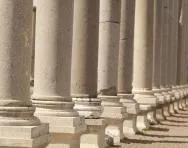
What was the Roman Empire?
The ancient Romans were based in Rome in Italy, but they ruled over land that stretched far beyond the borders of Rome. This was called the Roman Empire , and it covered large parts of land all around the Mediterranean Sea – and even part of Great Britain.
The Romans got this land mostly by fighting battles with other groups of people, like the Celts in Britain – when the Romans won, they’d get more territory to add to the Empire. This meant that Roman culture had a huge influence on other cultures, and it’s why finding Roman artefacts (like coins), and ruins of Roman walls and buildings (like Hadrian’s Wall) is so common in the British Isles today.
Top 10 facts
- Rome was a republic before it became an empire – it was governed in a different way, and had rulers that were elected through votes.
- The Roman Empire began in 27 BC , and after that single emperors ruled, one after the other, until their deaths. The first emperor was Caesar Augustus.
- Rome had a mix of very good emperors, like Augustus, and very bad emperors, like Nero.
- The first 200 years of Roman Empire is called the Pax Romana, which means ‘Roman peace’. It was a time of great prosperity for the Romans.
- The Romans had already won a lot of land through battles when Rome was a Republic. One famous military commander was Julius Caesar .
- Roman armies were known for being excellent in battle – they used their weapons well, they worked well as a team and they nearly always defeated their enemies.
- The Romans invaded Britain and started ruling it in 43 AD.
- When the Romans were in Britain, they based themselves in London, which they called Londinium.
- The Romans left Britain in 410 AD because the armies were needed to defend other parts of the Empire. The Anglo-Saxons were the next people to rule England.
- The Roman Empire lasted for a long time. It split into two parts in 285 AD, with the Western Empire ending in 476 and the Eastern Empire being overthrown in 1453.

Roman Empire Timeline
- 753 BC Rome was founded
- 509 BC The Roman Republic was founded
- 264-241 BC The First Punic War took place between the Romans and Carthaginians
- 218-201 BC The Second Punic War took place between the Romans and Carthaginians
- 149-146 BC The Third Punic War took place between the Romans and Carthaginians
- 58-51 BC The Gallic Wars took place

- 44 BC Julius Caesar was killed
- 27 BC Caesar Augustus became the first Roman Emperor, which marked the start of the Roman Empire; the Pax Romana began
- 43 AD Britain was invaded again, and this time the Romans stayed.
- 64 AD A fire in Rome lasted for six days, which affected most of the city – it is known as the ‘Great Fire’

- 80 AD The Colosseum opened
- 83 AD The battle of Mons Graupius took place in northern Scotland

- 180 AD Emperor Marcus Aurelius died, Emperor Commodus came to power, and the Pax Romana ended
- 285 AD The Roman Empire was split into two parts – East and West
- 410 AD The Romans left Britain, ending their rule
- 476 AD The Western Empire was conquered
- 1453 The Eastern Empire was conquered

Start your child on a learning programme today!
- Maths & English resources delivered each week to your dashboard
- Follows the National Curriculum
- Keeps your child's learning on track
Did you know?
- The first Roman emperor, in 27 BC, was Caesar Augustus, Julius Caesar ’s adopted son. That’s why 27 BC marks the start of the Roman Empire.
- In the Roman Empire, coins were more than just money – they were ways for the emperor to tell the people about the great things they had done (or wanted people to think they had done). A coin could be minted that showed pictures of the emperor with their name or other words and symbols on it.
- The Romans invaded Britain in 43 AD. Julius Caesar had tried to conquer Britain a couple of times before – in 55 and 54 BC – but hadn’t been successful.
- The Romans decided they didn’t want to take over land as far north as Scotland, so they built a wall to separate England and Scotland and keep out the Celtic tribes who lived there. This is called Hadrian’s Wall because Hadrian was the Roman emperor at the time. You can still see the wall today.
- When the Romans arrived in Britain, they got to work straight away building roads and forts so they could transport soldiers around the country. They also built things that they would have used if they were still in Italy, like bath houses and villas.
- Britain was just a very small part of the Roman Empire. The Romans ruled land all around the Mediterranean Sea, including parts of northern Africa and around the Black Sea.
- Roman armies were very well trained and organised. They were hard to beat, which helped the Roman Empire expand so quickly and conquer more lands.
- Roman soldiers had to be at least 20 years old when they joined the army, and they had to stay in the army for 25 years. After that, they were rewarded well with some money or land that they could farm.
Roman Britain gallery
- Hadrian’s Wall
- The location of Hadrian’s Wall
- The Roman Baths in the city of Bath
- A statue of Caesar Augustus
- What Roman soldiers would have looked like
- A gold coin with Emperor Hadrian on it
- A modern-day re-enactment of a Roman chariot race
- Modern-day people recreating a Roman legion
- A Roman mosaic in the British Museum
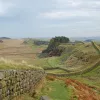
Before it was ruled by emperors, Rome was a republic and ruled by the senate along with two consuls leading.
Roman emperors ruled for their entire lives, but their succession didn't work like kings in a monarchy – someone in their family wasn’t guaranteed to be the next emperor. The senate was still around even though Rome wasn’t really a republic anymore, and if they or the Roman military didn’t like the next person in line then they’d find someone else to be emperor instead.
The people running things in Britain when the Roman armies invaded in 43 AD were the Iron Age Celts. Determined to take over the lands Julius Caesar had tried to conquer almost a hundred years before, the Roman emperor Cladius began the conquest of Britain by landing on the southeast coast and gradually laying siege to more and more hillforts where the Britons, people who belonged to different Celtic tribes, lived.
Some Celts accepted the fact that the Romans were in the land they called Britannia to stay, but others still tried to fight to get them to leave. In 60 AD there was a significant uprising, led by Queen Boudica of the Iceni tribe in East Anglia. Although the Britons were initially successful and destroyed Colchester, the Roman capital, they were defeated in 61 AD.
The Romans advanced into Wales and Scotland under the command of a governor called Agricola, but withdrew from Scotland after his death in 84 AD. In 122 AD the Roman emperor Hadrian decided to build a frontier wall to keep the northern tribes from attacking and protect Roman Britain. Hadrian's Wall was the largest structure in the Roman emore and stretched for 75 miles (120km) across the north of England, between the rivers Tyne and Solway.The Wall marked the official border between the Roman empire and the tribes who lived in Caledonia (Scotland).
The key to the Romans' invasion of Britain was the strength of their army, the largest and most powerful military force of its day.
This is how Roman armies were divided up and organised:
- A Roman army consisted of 30 legions, with each legion having between 4,000 and 6,000 legionaries (certain kinds of solders) in it.
- A legion was commanded by a legate, and had 10 cohorts.
- A cohort had six troops.
- A troop had 80 legionaries, also called centuries.
- Centuries were led by a centurion.
Roman soldiers had different roles and responsibilities:
- Legionaries were paid the most and were the most highly trained.
- Auxiliaries were soldiers who weren’t Roman citizens; they weren’t paid as much as legionaries and did jobs like guarding forts or being in the front line of battle.
- Artillery soldiers were in charge of catapults, which could fire things into the air and over onto the enemy’s armies or buildings.
- The cavalry were soldiers who rode horses when they fought.
- The infantry were soldiers who marched on foot.
Soldiers fought with both their weapons (swords, spears and javelins) and with their shield, which was called a scutum. They’d hold up their scutum to defend themselves in battle, or they’d join with other soldiers to form one big shield if they wanted to advance. Soldiers on the inside of the group held their scutum up over their head, while the soldiers on the outside of the group held their scutum out to form a ring. This formation was called the testudo, which is the Latin word for tortoise. Nothing was going to get past that!
After Roman rule was established in Britain, the Roman army began to act as a peacekeeping force and the Romans brought their customs and culture to their new lands.
They built towns around England to help them govern it better and keep organised, which the Celts didn’t really have before. The largest one was London, which they called Londinium; by the end of the first century London had become one of the great cities of the Roman empire. Other large towns were Colchester, St. Albans and Aquae Sulis (now Bath).
Roman towns were all laid out in the same way – each had straight streets shaped in a grid pattern, with buildings like a public bath house, temple, aqueducts and an amphitheatre. They also had forums, which were big open squares where people could set up stalls to sell things. A lot of these features were in Rome, so having them in these new towns in England helped the Romans feel more at home.
Roads were also and important part of Roman life (have you ever heard the saying, "All roads lead to Rome!"?). Around 2000 miles (or 3200 km) of paved roads running between towns or cities were constructed in Britain by the Romans.
The Roman emperors were a mixed group of some good rulers, and some very bad rulers. But whether the emperors were good or bad, things worked out pretty well for the Roman Empire during its first 200 years – this was called the Pax Romana (‘Roman peace’) and was a time of great prosperity.
Eventually, the Roman Empire became too big to rule very well. In 285 AD, Emperor Diocletian split the Roman Empire in two halves, East and West. The Western Empire ended in 476, and the Eastern Empire carried on until 1453.
Britain was part of the Western Empire, but the Romans left it in 410 AD , well before the end of the Western Empire. This was because the soldiers and leaders who ruled Britain were needed to defend other parts of the Empire. All of the roads, buildings, coins, forts and other things that the Romans had created in Britain were left, which is why we can find so many things from the Roman period around England and Wales today.
Roman names to know:
Hannibal (247-183 BC) – Hannibal was a military leader from Carthage, who fought against the Romans in the Punic Wars. He is known for bringing an army of soldiers and elephants over the Pyrenees Mountains and the Alps into northern Italy, which at first was successful in fighting against Rome. The Roman military eventually worked out how to beat Hannibal’s army and won, but Hannibal’s tactics are still thought to be pretty impressive today.
Augustus (63 BC-14 AD) – Augustus was the first emperor of Rome. After Julius Caesar died, Augustus formed a new government with Marc Antony and Marcus Lepidus – a triumvirate. It fell apart about 10 years later though, with Augustus the only one left to rule. He worked out new laws that formed the Roman Empire, which was then governed by one person for their lifetime.
Claudius (10 BC-54 AD) – Claudius was the fourth Roman emperor. The invasion of Britain happened while he was Emperor, and he was responsible for building new roads and aqueducts across other parts of the Empire.
Nero (37-68 AD) – Nero became the Roman emperor after Claudius. He spent a lot of money building theatres and having athletic competitions, and he became pretty unpredictable. If he thought someone was threatening his power, he’d usually have them killed. He was emperor during the Great Fire of Rome, and some people thought he started it himself so he’d have room to build a new palace. Whether or not that’s true, the Roman senate became more and more frustrated with him and told him he was going to be arrested and put to death. Rather than have that happen, Nero killed himself.
Hadrian (76-138 AD) – Hadrian was the 14th Roman emperor, and ruled during a very successful time for Roman Britain. He is known for having a wall built along the border of England and Scotland (Hadrian’s Wall) and for rebuilding the Pantheon, a temple to the gods that the Romans believed in. He is also the third in a group of five emperors called ‘the Five Good Emperors’.
Marcus Aurelius (121-180 AD) – Marcus Aurelius was the last Roman emperor of the Pax Romana, and also the last of the ‘Five Good Emperors’. The Roman Empire expanded even further during his reign.
Constantine (272-337 AD) – Constantine the Great was proclaimed emperor in York. He was the first emperor who was also a Christian, and he tried to unify the Roman Empire again after it had been split into the East and West. He moved the capital from Rome to a new city which he called Byzantium, later called Constantinople after him. Today, it is called Istanbul, which is the largest city in Turkey.
Related Videos
Just for fun...
- Become the face of the emperor on your very own Roman coin in a virtual Roman coin hoard
- Decipher tablet writing, make Roman honey cake, complete Roman wordsearches and paint by Roman numerals on the Vindolanda Charitable Trust home learning website
- Make a delicious Roman burger from a 1500-year-old recipe
- Reading Roman numerals
- Build your own Roman mosaic online
- Dress up as a Roman god or goddess with a downloadable Roman gods dress-up kit
- Play a Roman numerals bingo game online
Best children's books about Roman Britain and the Roman Empire
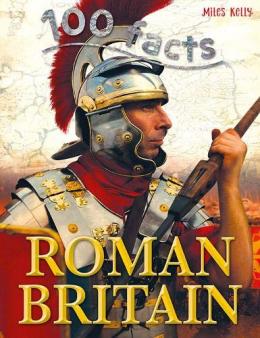
Find out more about Roman Britain
- Watch BBC Bitesize animated videos about how the Romans conquered Britain , how the Romans conquered Scotland , life in Roman Britain , what life was like in the Roman army and how the Romans changed Britain
- See a children's diagram of the Roman Empire through time
- An introduction to Roman Britain (AD 43 to around 410)
- See a picture gallery of Hadrian’s Wall
- Learn about daily life in Roman Britain
- Understand how and why the Romans built a network of roads in Britain with a BBC Bitesize video
- Children's information about Roman baths and how they worked
- Find out about the food and drink brought to Britain by the Romans
- Read 30 fascinating facts about Hadrian's Wall
- Watch historian Bethany Hughes in BBC video clips about the history of the Roman Empire , public baths in Roman Britain and soldiers' lives in Roman Britain
- Get a slave's view of life in the Roman empire
- Read kids' fiction books set in Ancient Rome
- Understand why public bathing was such an important part of Roman life
- Get an overview of Roman Britain and life in Roman Britain by examining a variety of British Museum objects like coins, pots, stonework, statues and writing tablets
- Read about ingenious innovations the Romans brought to Britain
- Look at artefacts from the Arbeia Roman Fort , which once guarded the entrance to the River Tyne
- How Roman roads were built
- Fragments of ancient Roman waxed writing tablets have been found in London . The writing on them includes the first known reference to London and the earliest hand-written document found in Britain!
- Some Latin words are used when we speak English . Do you know what they mean?
- Explore life in Britain after 43AD with BBC Schools Radio's collection of KS2 audio clips about Roman Britain
- "Meet" a Roman merchant in Londinium and find out about how people from different parts of the Roman Empire travelled and traded with each other
See for yourself
- Check a map of Roman sites in Britain
- See the defensive wall that the Romans built in London and walk around the remains of the London Wall before visiting the Roman London gallery in the Museum of London ( download an activity pack before you go)
- A complete guide to the sites of Hadrian's Wall , a frontier that spanned 80 miles of Britain, from coast to coast
- Walk along part of Hadrian’s Wall , and see a Roman fort
- The largest Roman amphitheatre in Britain was in Chester
- Visit the Roman Britain and Roman Empire galleries in the British Museum in London
- Explore the Roman Baths in the city of Bath on Google Street View or visit the Roman Baths in person
- Ambleside Roman fort in Cumbria
- The Roman wall of St. Albans
- Colchester was one of the largest Roman towns in England
- Step into a reconstructed Roman forge and see a replica Roman water lifting machine at the Ancient Technology Outdoor Education Centre
- Arbeia Roman Fort is a UNESCO World Heritage site which offers visitors full-scale Roman reconstructions
- Butser Ancient Farm features archaeological reconstructions of buildings from Roman times
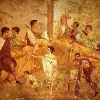
Give your child a headstart
- FREE articles & expert information
- FREE resources & activities
- FREE homework help
The Complete Old Western Culture Series
All four years of old western culture.

Complete Old Western Culture Curriculum Package
$ 1,196.00 – $ 2,332.00
“Western Civilization, in a box!” This Complete Set package includes all four years of Old Western Culture . Old Western Culture is a narrative guide through the great books covering over 130 works and built around award-winning video lectures featuring five veterans of classical education. The course has three primary components: The central video course, workbooks, and readers. Below you can choose which format you prefer. Physical products always include the digital version as well.
SUMMER SALE: The Complete Old Western Culture Package enjoys our DEEPEST discount during the Summer Sale, at 35% off!
- Description
- What Works are Covered?
- Lecture List
What's Included?
The entire Old Western Culture curriculum, which includes 192 lectures (approx 128 hr runtime) covering over 130 of the great books of Old Western Culture, starting with Homer’s Iliad , through the Early Moderns, ending with a hat-tip to the 20th Century authors C. S. Lewis, G. K. Chesterton, and J. R. R. Tolkien in the unit The Novels (unit 16). In addition to the video lectures, each includes a Student Workbook , a Reader containing all assigned readings, Exams (two Student Exams and Teacher’s Edition with grading guide), and a Guide to the Art (for The Greeks and The Romans).
OLD WESTERN CULTURE BY THE UNIT
Year one: the greeks, unit 1: the epics.
The Epics covers the two great poems of Homer: The Iliad and the Odyssey . Join Wesley Callihan, a veteran teacher of the classics, as he guides the student through the world of Homer. In story-like fashion, he steers the reader through the plot, poetic devices, background, philosophy, history, and beauty of the poems, as well as how we should approach these monuments of Western culture from a Christian perspective.

Unit 2: Drama and Lyrics
Drama and Lyric covers the beginning of drama and some of the earliest comedies and tragedies known to the Western world. This course includes lectures on the three primary tragedians from the Ancient Greek world by Sophocles, Aeschylus, and Euripides and also one of the most famous writers of Greek comedy, Aristophanes. The course also offers an introduction to Greek lyric poetry from the same era, including passages by Pindar, Sappho, and Quintus of Smyrna. A lecture on the minor epic poetry of Hesiod is also included as a complement to part Greeks: The Epics .

Unit 3: The Histories
The Histories introduces students to three of history’s most influential early historians. Students will learn about Herodotus, the “Father of History”, as they read his masterpiece, The Histories , and its inquiries into the origins of the Greco-Persian Wars. They will read and learn about Thucydides’ History of the Peloponnesian War and its forays into the earliest expressions of political philosophy. And last they will read Xenophon’s Anabasis , the famous account which reads like a novel as it chronicles the march of ten thousand Greeks soldiers on their treacherous journey home through enemy territory.

Unit 4: The Philosophers
The Philosophers covers the most important works of Plato and Aristotle and introduces students to the ideas that have been wrestled with by Western Civilization for over two thousand years. The texts covered in this unit include Plato’s Apology, Crito, Phaedo, Phaedrus, and Republic ; and Aristotle’s Metaphysics, Ethics, and Poetics . Wesley Callihan draws from decades of teaching experience as he unpacks the concepts, dispels common misconceptions, and explains how the Christian church and society at large have been influenced by the ideas of these men—both for good and for ill.

YEAR TWO: THE ROMANS
Unit 1: the aeneid.
The Aeneid unpacks one the greatest classics of the West, the Aeneid of Vergil, whose impact profoundly influenced both Roman society and medieval Christianity. Wesley Callihan guides the student through the plot, poetic devices, background, philosophy, history, and aesthetics of the poem, as well as its lasting influence on Western culture and civilization.

Unit 2: The Historians
The Historians guides students through the writings of Livy, Tacitus, Sallust, Julius Caesar, Plutarch, Quintilian, and Cicero. Discover the original works that chronicle the early history of Rome from Monarchy, through Republic, to Empire. In this unit you will discover how the Roman philosophy of history shaped the lives and culture of the Roman people, how the Roman historians recognized the signs of cultural decay in their own day, and finally, how the persecution of the Early Church played a critical role in the spread of Christianity throughout the empire.

Unit 3: Early Christianity
Early Christianity introduces students to the writings of the post-apostolic authors and their historical context. Learn about the persecutions of the early Christians and how they held fast to the faith as chronicled by the historian Eusebius. As the Church becomes more established, learn how early theologians defended the faith against various false doctrines, as was the case with Irenaeus, the Bishop of Lyon. Learn about the writings of The Apologists, Clement of Alexandria, and Justin Martyr, as well as one of the earliest Christian text after the close of the Canon, the Didache.

Unit 4: Nicene Christianity
Nicene Christianity introduces students to the creeds and councils of the early Church and the fascinating story of how they came about. Wesley Callihan guides students through Augustine’s Confessions and City of God , and selections from John Chrysostom, Athanasius, and Boethius. Learn how the late Roman Christians viewed themselves as the last remnants of Paganism fell, and the Christian defense mounted by Augustine against the accusations that Rome fell because she abandoned the Pagan gods. Learn how Athanasius influenced the Council of Nicea as the Church gathered to discuss the deity of Christ.

YEAR THREE: CHRISTENDOM
Unit 1: early medievals.
Early Medievals, The Growth of European Christianity , introduces students to life in the Middle Ages from a Christian perspective. Students will read about the military exploits of the Eastern Roman Empire under the emperor Justinian as chronicled by Procopius, the last great historian of the Roman world. Learn how the development of monasticism preserved learning and culture after the fall of the Roman Empire. Learn about the central role that Irish Christianity played in the spread of the gospel through the lives of St. Patrick, Bede, and others. Enjoy the timeless tales of Beowulf, Alfred and Great, and the origins of Arthurian legend that have shaped the Anglo-Saxon imagination for centuries.

Unit 2: Defense of the Faith
Defense of the Faith , Scholasticism in the High Middle Ages , immerses students into one of the most misunderstood periods of history. Start by learning about Anselm’s theological defense of the faith as he explains his ontological argument for the existence of God. Through Monmouth’s History of the Kings of Britain , learn about the background to the Crusades. Finally, learn about the Crusades themselves, both the good, and the bad. Don’t miss the harrowing tales of Vikings escaping Constantinople and knights fighting for the faith!

Unit 3: The Medieval Mind
The Medieval Mind begins by guiding students through the basics of Thomas Aquinas’ Compendium , introducing students to the medieval mindset which greatly influenced later theologians and philosophers. With this foundation, students embark on a journey through Dante’s conception of Hell, Purgatory, and Paradise in The Divine Comedy , exploring medieval concepts of guilt, atonement, beauty, and the cosmos. Meet many classic characters from the Greeks to Dante’s present day as Dante uses his allegory to explore human nature, as well as the politics of his day.

Unit 4: The Reformation
The Reformation introduces students to the great minds of the Reformation: John Calvin, Martin Luther, Thomas Cranmer, and Erasmus. But a study of this tumultuous period of history would be sorely lacking without a thorough understanding of the historical setting of the Reformation. Wesley Callihan and Dr. Chris Schlect team up to lay a solid foundation for understanding the origins and struggles of the Reformation, as well as its theology and influence. Students will read part of Calvin’s Institutes of the Christian Religion , as well as Chaucer’s Canterbury Tales and Spenser’s Faerie Queene .

YEAR FOUR: EARLY MODERNS
Unit 1: rise of england.
Rise of England introduces students to some of the greatest poetry composed in the English language. Dr. Peter Leithart guides students through the three major play types by looking at the tragedy of King Lear, the history of Richard III, and the comedy of The Merchant of Venice, as well as six of Shakespeare’s sonnets. Wesley Callihan then guides students through the great epic poem: John Milton’s Paradise Lost, as well as the poetry of George Herbert, John Donne, and Marvell. Learn about the influence this poetry had on England in its day, and the lasting legacy of these works in culture to this day.

Unit 2: Poetry and Politics
Poetry and Politics guides students through a tumultuous period of significant change in Western civilization. Nations and individuals grapple with questions of identity, what it means to be free, and what it means to be human. Enjoy the poetry of Pope, Coleridge, Wordsworth, Byron, Keats, Shelley, Tennyson, Browing, Arnold, Rossetti, Hopkins, and Poe. Explore the political treatises of Edmund Burke and Alexis de Tocqueville. Learn how these works reflect the period and influenced future generations.

Unit 3: The Enlightenment
The Enlightenment begins with an introduction by Dr. Mitch Stokes to background of the Enlightenment of the 18th century, starting with the Greek Pythagoreans and the “problem of change” and tracing those issues to the Scientific Revolution. Students learn about the search for certainty that led to skepticism through the works of Galileo, Descartes, Newton, Hume, Kant, and finally Reid, as each philosopher grapples with the nature of knowledge.

Unit 4: The Novels
The Novels guides students through Dickens’s heartwarming A Christmas Carol , and then turns to Dostoevsky’s darker Russian tale, The Brothers Karamozov , as well as Chekhov’s The Bet . A study of Austen’s Pride and Prejudice looks at both the story and the social setting of England during this period. Old Western Culture concludes with a hat-tip to two of the 20th-century revivors of the great books: C. S. Lewis, who coined the term “old Western culture,” and J. R. R. Tolkien, with guest lecturer Jonathan McIntosh, who guides students through the story and themes of The Lord of the Rings .

WHAT IS “OLD WESTERN CULTURE”? “Old Western Culture” is a literature curriculum named after a term coined by C.S. Lewis to describe the fabric of ideas that shaped Western Civilization. For centuries, a “Great Books” education lay at the heart of what it meant to be educated. It was the education of the Church Fathers, of the Medieval Church, of the Reformers, and of all the Founding Fathers of the Unites States. – It is a CLASSICAL EDUCATION, based on the great books of western civilization. – It is a CHRISTIAN EDUCATION, which sees the history and literature of the West through the eyes of the Bible and historic Christianity. – It is an INTEGRATED HUMANITIES CURRICULUM, bringing together literature, history, philosophy, doctrine, geography, and art. – It is a HOMESCHOOL oriented curriculum, made by homeschoolers with the needs of homeschooled in mind, including flexibility, affordability, and ease-of-use for home and co-ops. We bring a master-teacher into your home or co-op, and encourage parents to gain an overview of Western Civilization themselves by watching the video lessons with their children.
HOW DOES OLD WESTERN CULTURE WORK? Old Western Culture is a video course. It is built around a master teacher, Wes Callihan. With decades of teaching experience, he guides students through the story of Western civilization. Each unit contains 12 video lessons (48 lectures in year 1, approx 30-40 min each). Each lesson begins with a brief review before jumping into summary, commentary, analysis, and inter-disciplinary connections of the works covered. After each lesson, students complete the assigned readings, and answer comprehension questions in the Student Workbook or online workbook.
WHY DO PEOPLE LOVE WES CALLIHAN? Wes Callihan is a master storyteller! With a remarkable ability to communicate a passion for history and literature, he makes profound ideas accessible, relevant, and interesting. Also known for his distinctive “rabbit trailers,” forays into funny and obscure historical anecdotes, which have a way of showing up at the dinner table. (After all, rabbit trails are “hooks for the imagination and memory.”) Wes Callihan is a true classical scholar, fluent in both Latin and Greek. He lectures only from the notes in the margins of his worn copies of the Great Books. “Meet him” through THIS VIDEO TOUR of his personal library, which doubled as a mini-lecture!
PREREQUISITES Old Western Culture is intended for mature and discerning students. We recommend this course for ages 14 and up. The course will deal with mature themes such as paganism, sexual immorality, battle scenes (mostly in actual reading), and classical paintings. Old Western Culture is meant to equip your child with a Biblical lens from which to process these themes. We assume your child has a working knowledge of the Bible and basic Christian doctrine.
CREDITS Each year of Old Western Culture is a double-credit Humanities course which is most commonly broken down into 1 Literature credit and 1 History credit. The double-credit assumes that the student will watch all the videos, read the required reading, answer the daily worksheets, and take 4 exams (one for each unit). This a robust course academically, and requires a fair bit of reading. Wesley Callihan will coach your student on how to approach the reading in the video. Average daily reading load is 30-40 pages. As an “integrated humanities” course, Old Western Culture will constantly be incorporating history, literature, theology, philosophy, art, and art history, all through the eyes of the Great Books.
See the Old Western Culture Great Books List .
Also, see the Essentials Schedule .
COMPLETE LECTURE LIST FOR THE GREEKS
THE EPICS: Lecture 1 – Introduction to Old Western Culture Lecture 2 – The Backdrop to the Iliad. Lecture 3 – The Anger of Achilleus. (Iliad I-IV) Lecture 4 – The First Critical Turning Point. (Iliad V-IX) Lecture 5 – The Deception of Zeus. (Iliad X-XV) Lecture 6 – The Second Critical Turning Point. (Iliad XVI-XXI) Lecture 7 – The Death of Hektor. (Iliad XXII-XXIV) Lecture 8 – The Telemachy. (Odyssey I-IV) Lecture 9 – The Court of Alkinoös. (Odyssey V-VIII) Lecture 10 – Odysseus Tells of his Wanderings. (Odyssey IX-XII) Lecture 11 – The Homescoming of Odysseus & The Judgement of the Suitors. (Odyssey XIII-XXIV) Lecture 12 – he Legacy of Homer in Western Civilization.
DRAMA AND LYRIC: Lecture 1 – Background of Greek Drama: Development of Theater Lecture 2 – Background of Greek Drama: The Period, the Poets, and the Presentation Lecture 3 – Aeschylus’ Oresteia: The Agamemnon Lecture 4 – Aeschylus’ Oresteia: The Libation-bearers and The Eumenides Lecture 5 – Sophocles’ Oedipus the King Lecture 6 – Sophocles’ Oedipus at Colonus Lecture 7 – Euripides’ Medea and Trojan Women Lecture 8 – Aristophanes’ The Frogs and The Clouds Lecture 9 – Lyric Poetry: Sappho and Pindar, and Theocritus Lecture 10 – Lyric Poetry: Hesiod Lecture 11 – Lesser Epics: Quintus of Smyrna, The Fall of Troy Lecture 12 – Lesser Epics: Apollonius of Rhodes, The Argonautica
THE HISTORIES: Lecture 1 – Overview of Greek History Lecture 2 – Herodotus 1: Introduction and Croesus Lecture 3 – Herodotus 2: Stories of Egypt and the other nations Lecture 4 – Herodotus 3: The Beginning of the Persian Wars and the Battle of Marathon Lecture 5 – Herodotus 4: The Battle of Thermopylae Lecture 6 – Herodotus 5: The Battle of Salamis, and the End of the Persian Wars Lecture 7 – Thucydides 1: Introduction, Thucydides’ Philosophy of History, and the Beginning of the Peloponnesian War Lecture 8 – Thucydides 2: The Early Years, Pericles, and the Great Plague Lecture 9 – Thucydides 3: Mytiline, Exile, Revolution, and Melos Lecture 10 – Thucydides 4: The Sicilian Campaign, and the Downfall of Athens Lecture 11 – Xenophon: The March of the Ten Thousand Lecture 12 – The Lessons of Greek History
THE PHILOSOPHERS Lecture 1 – Overview of Greek philosophy, introduction to Socrates, Plato, and Aristotle Lecture 2 – Plato: The Apology: Socrates, St. Paul, and The Doctrine of Wisdom Lecture 3 – Plato: The Crito and Phaedo: Socrates, Christianity, and the doctrine of body and soul Lecture 4 – Plato: The Phaedrus: Socrates, Augustine, Dante, C. S. Lewis, and the Dialectic of Desire; True teaching Lecture 5 – Plato: The Republic: understanding morality Lecture 6 – Plato: The Republic: The Forms and the influence on Medieval Christendom Lecture 7 – Aristotle: The Metaphysics: Aristotle, Aquinas, and the Doctrine of Wisdom Lecture 8 – Aristotle: The Metaphysics: the Cosmos in Antiquity and the Middle Ages Lecture 9 – Aristotle: The Ethics: Happiness the Chief End of Man Lecture 10 – Aristotle: The Ethics: Friendship Lecture 11 – Aristotle: The Poetics: Stories, Oedipus, and Jane Austen Lecture 12 – The Lessons of Greek Philosophy
COMPLETE LECTURE LIST FOR THE ROMANS
THE AENEID: 1. Introduction to The Romans: Overview of Roman History, its importance to Old Western Culture, and a Survey of the books Covered in this series 2. Introduction to the Aeneid: Vergil, Secondary Epic, and the Writing, Worldview, and Influence of the Aeneid 3. Rome is an Idea (Aeneid Book I) 4. The Fall of Troy and The Wanderings of Aeneas (Aeneid Book II & III) 5. The Tragedy of Dido (Aeneid Book IV) 6. The Underworld (Aeneid Book V & VI) 7. The Broken Truce and the Shield of Aeneas (Aeneid Book VII & VIII) 8. The Tragedy of Nisus and Euryalos (Aeneid Book IX & X) 9. Camilla, Juno’s Surrender, and the Death of Turnus (Aeneid Book XI & XII) 10. Metamorphoses I 11. Metamorphoses II 12. The Epics of Lucretius, Lucan, and Statius
THE HISTORIANS: 1. Livy I: Philosophy of history and the monarchy 2. Livy II: Beginning and Heroes of the Republic 3. Livy III: Threats to the Republic 4. Tacitus I: Philosophy of history and Tiberius 5. Tacitus II:Claudius 6. Tacitus III:Nero 7. Sallust: The Jugurthine War and the The Conspiracy of Catiline: The Republic in Decay 8. Julius Caesar: The Gallic wars 9. Plutarch’s Lives I: Demosthenes and Cicero 10. Plutarch’s Lives II: Alexander and Caesar 11. Cicero: Against Verres and Against Antony 12. Overview of The Historians
EARLY CHRISTIANITY: 1. The Roman Background of Christianity 2. The Jewish Background of Christianity 3. The Didache 4. The First Letter of Clement 5. The Roman World in the Second and Third Centuries 6. Ignatius and Polycarp 7. The Apologists 8. Justin Martyr 9. Irenaeus 10. Clement of Alexandria and Origen 11. Eusebius I 12. Eusebius II
NICENE CHRISTIANITY: 1. Constantine and The Council of Nicea 2. The Nicene and Post-Nicene Age 3. Athanasius’s On the Incarnation 4. Athanasius’s Life of Anthony 5. John Chrysostom 6. Augustine’s Confessions I 7. Augustine’s Confessions II 8. Augustine’s City of God I 9. Augustine’s City of God II 10. Augustine’s City of God III 11. Augustine’s City of God IV 12. Boethius and the Consolation of Philosophy
COMPLETE LECTURE LIST FOR CHRISTENDOM
Early Medievals Lesson List: 1. Historical Overview of Christendom 2. Benedict’s Rule and Monasticism 3. Transition to the Middle Ages 4. Procopius and Gregory 5. Maximus the Confessor 6. Celtic Christians 7. Beowulf 8. Bede I: Early History of England 9. Bede II: The Coming of Christianity 10. Bede III: The Confirming of Christianity 11. Lives of Charlemagne and Alfred 12. John of Damascus
Defense of the Faith: 1. Historical Overview of the High Middle Ages 2. Anselm’s Ontological Argument 3. Anselm’s Monologium 1 4. Anselm’s Monologium 2 5. Anselm’s Why God Became Man 1 6. Anselm’s Why God Became Man 2 7. History of the Kings of Britain 1 8. History of the Kings of Britain 2 9. The Golden Legend 10. Historical Overview of the Crusades 11. The Conquest of Constantinople 12. The Life of St. Louis
The Medieval Mind: 1. Introduction to The Medieval Mind 2. Aquinas’ Compendium I 3. Aquinas’ Compendium II 4. Aquinas’ Compendium III 5. Introduction to Dante 6. The Inferno I 7. The Inferno II 8. Purgatorio I 9. Purgatorio II 10. Paradiso I 11. Paradiso II 12 Conclusion
The Reformation: Lecture 1: Introduction to Renaissance and Reformation (Callihan) Lecture 2: Canterbury Tales 1 (Callihan) Lecture 3: Canterbury Tales 2 (Callihan) Lecture 4: Canterbury Tales 3 (Callihan) Lecture 5: From Premodern to Modern Times (Schlect) Lecture 6: Predecessors to the Reformation (Schlect) Lecture 7: Luther and 16th Century Reform (Schlect) Lecture 8: International Calvinism (Schlect) Lecture 9: The Reformation in England (Schlect) Lecture 10: Spenser 1 (Callihan) Lecture 11: Spenser 2 (Callihan) Lecture 12: Spenser 3 (Callihan)
COMPLETE LECTURE LIST FOR EARLY MODERNS
Rise of England: 1. Introduction to Early Moderns (Wesley Callihan) 2. Introduction to Shakespeare (Peter Leithart) 3. Shakespeare’s Sonnets (Peter Leithart) 4. Shakespeare’s King Lear (Peter Leithart) 5. Shakespeare’s Richard III (Peter Leithart) 6. Shakespeare’s The Merchant of Venice (Peter Leithart) 7. Metaphysical Poets: John Donne (Wesley Callihan) 8. Metaphysical Poets: George Herbert and Marvell (Wesley Callihan) 9. Introduction to Milton (Wesley Callihan) 10. Paradise Lost I (Wesley Callihan) 11. Paradise Lost II (Wesley Callihan) 12. Paradise Lost III (Wesley Callihan)
Poetry and Politics: 1. Introduction to Enlightenment 2. Alexander Pope I 3. Alexander Pope II 4. Edmund Burke I 5. Edmund Burke II 6. Romantic Poetry I 7. Romantic Poetry II 8. Victorian Poetry and Democracy in America 9. Edgar Allen Poe 10. Victorian Poetry I 11. Victorian Poetry II 12. Victorian Poetry III
The Enlightenment: 1. Introduction: What Is the Enlightenment? 2. The Scientific Revolution: An Overview 3. Galileo Moves the Earth 4. The Galileo Affair 5. Descartes & Skepticism 6. Descartes’ Search for Certainty 7. Did Descartes Succeed? 8. Descartes & the Scientific Revolution 9. Isaac Newton Takes the Throne 10. Hume: Taking Skepticism Seriously 11. Kant’s Answer to Hume 12. Thomas Reid & Genuine Enlightenment
The Novels: 1. Introduction to The Novels (Callihan) 2. Jane Austen I (Callihan) 3. Jane Austen II (Callihan) 4. Charles Dickens (Callihan) 5. Fyodor Dostoevsky (Callihan) 6. Russian Short Stories (Callihan) 7. J. R. R. Tolkien I: Fairy-Stories and The Lord of the Rings (McIntosh) 8. J. R. R. Tolkien II: Escape, Consolation, and Eucatastrophe (McIntosh) 9. J. R. R. Tolkien III: Themes in The Lord of the Ring (McIntosh) 10. C. S. Lewis I (Callihan) 11. C. S. Lewis II (Callihan) 12. Overview of Old Western Culture and the 20th Century (Callihan)
IMAGES
COMMENTS
Primary Homework Help The Romans. by Mandy Barrow : Celts. Romans. Saxons. Vikings. Normans. Tudors. Victorians. WW ll. 500 BC . AD 43. 450. 793. 1066. 1485. 1837. 1939 ... Roman roads sloped down from the middle to ditches on either side to allow the rain to drain away and not make the road too muddy.
Roman Kent. Two thousand years ago Thanet was cut off from the mainland by the Wantsum, a river or arm or sea stretching from the Thames estuary, near Reculver on the north, to Pegwell Bay on the east, and probably a mile or two wide. At the east end of the Wantsun the Romans created a haven (safe area) for their ships, protected from the sea ...
The Romans built Britain's first towns. They built towns all over Britain as centers to administer the people they had conquered. Within 17 years of the invasion, they had several major towns in place. connected by the famous Roman roads. Towns soon became important places for meetings and trade. Reconstruction of Roman Sichester
The Romans were famous for their roads, and this page describes how Roman roads were built and how you could use the topic in the classroom. The Romans built roads so that the army could march from one place to another. They tried to build the roads as straight as possible so that the army could take the shortest route.
Roads were a key aspect of transportation in the Roman Empire. In addition to the streets built within Roman cities, the Roman military built several major highways, starting with the Appian Way ...
The roads built by the Romans in Britain formed the foundations for the road networks we use today. With the help of our resources, your KS2 children can learn all about the Romans and their important creations. For example, your children can learn more about Roman inventions with the help of this informative Teaching Wiki.
Welcome to our Homework Help guide all about the Romans. Click through the chapters on the left-hand side to learn more about this famous period of time! As well as help with your homework, these guides contain lots of exciting activities that you can try at home and plenty of fun facts that you can impress your family and friends with.
An 8 lesson series guiding Key Stage 3 through some of the fundamentals of the Roman Empire. Tried and tested over a number of years. See details of each lesson below the initial list. Each lesson focusses on the Video - Resource - Quiz structure to allow for maximum support for teachers and parents - and maximum independence for students.
Few roads remain in Germany, but the oldest still-standing bridge in the country is of Roman origin: the Manfred Bridge, in Trier. A UNESCO World Heritage site , the bridge spans the river Moselle ...
Roman History homework help for Kids KS2. Learn about the Roman Empire, Roman Britain & Roman Life. ... The Romans facts for kids KS2 learning at Primary School. Homework help with the history of Romans, the Roman Empire and places to visit in the UK where you can learn more about the Romans. ... They built everything from road, bridge and ...
The ancient Romans lived in a city called Rome. Rome still exists today, and it is the capital of Italy. The Romans and their culture had a big impact on how we live our lives today, and gave us things like ways to get clean water, ways to build roads and even the basis of our language. Britain was part of the Roman Empire for amost 400 years ...
The Romans came to Britain nearly 2000 years ago and changed our country. Even today, evidence of the Romans being here, can be seen in the ruins of Roman buildings, forts, roads, and baths can be found all over Britain. The Romans invaded other countries too. The Roman Empire covered much of Europe, north Africa, and the Middle East. ( see map)
Maths. Figure out Roman road routes around your school using only straight lines and right angles. Learn to count using Roman numerals. Try this BBC Romans shopping challenge and extend it with your own numbers. Investigate the areas of different Roman villas. Weigh out ingredients to make Roman bread. Work out how you would need to scale up ...
The Romans left Britain in 410 AD because the armies were needed to defend other parts of the Empire. The Anglo-Saxons were the next people to rule England. The Roman Empire lasted for a long time. It split into two parts in 285 AD, with the Western Empire ending in 476 and the Eastern Empire being overthrown in 1453.
A video introducing the Romans. The video below contains many photographs and will take a few minutes to connect and start loading. It is a good introduction to the Roman Empire and the soldiers. The video is running across the internet, so many buffering episodes will take place. This video is best viewed again once the red bar has fully loaded.
For centuries, the study of the great books has been central to education. Old Western Culture is your guide through the great books. Old Western Culture is a robust great-books, dual-credit honors-level curriculum, but it is first and foremost storytelling. Learn, appreciate, and inherit "old Western culture" as C.S. Lewis coined the term.
Veteran history teacher Dave Raymond gives a comprehensive history of the United States by applying a Christian worldview to the characters, events, theology, literature, art, and religious beliefs of the nation. It is an engaging class for Middle School and High School students. Grades: 7-12+. Format: Video course and Readers.
Complete Old Western Culture Curriculum Package. $ 1,196.00 - $ 2,332.00. "Western Civilization, in a box!". This Complete Set package includes all four years of Old Western Culture. Old Western Culture is a narrative guide through the great books covering over 130 works and built around award-winning video lectures featuring five ...
Roman Roads Media, Moscow, Idaho. 3 likes. Roman Roads Media is a publisher of classical Christian curriculum, with an emphasis on video curriculum....
The Romans thought that their gods were all part of a family and people told stories or myths about them. The most important gods to the Romans were the Greek gods from Mount Olympus. The Greek gods were given Roman names, for example, Zeus became Jupiter. Their gods included: Jupiter. King of the Gods. God of the sky; Weapon: Thunderbolt